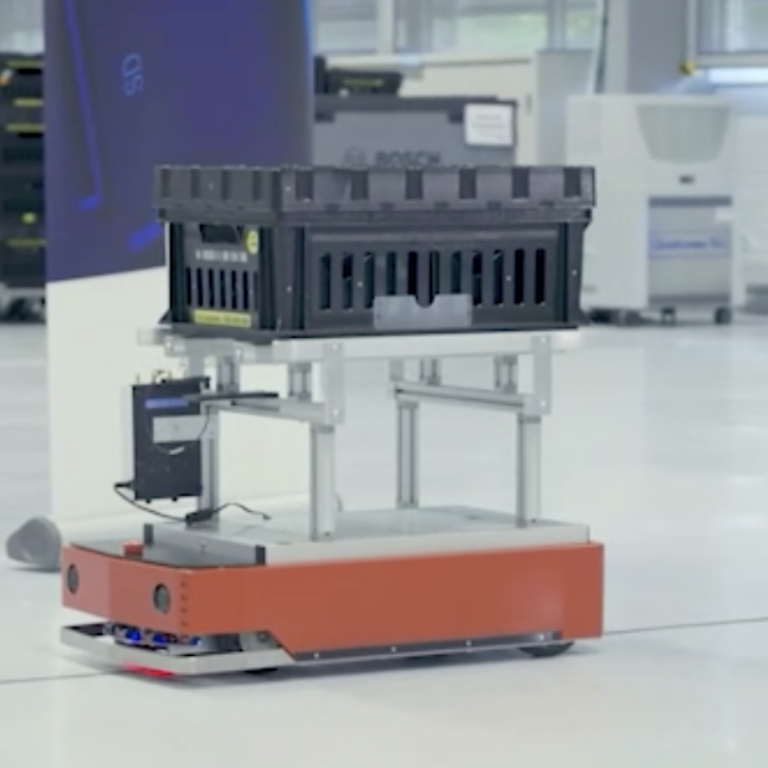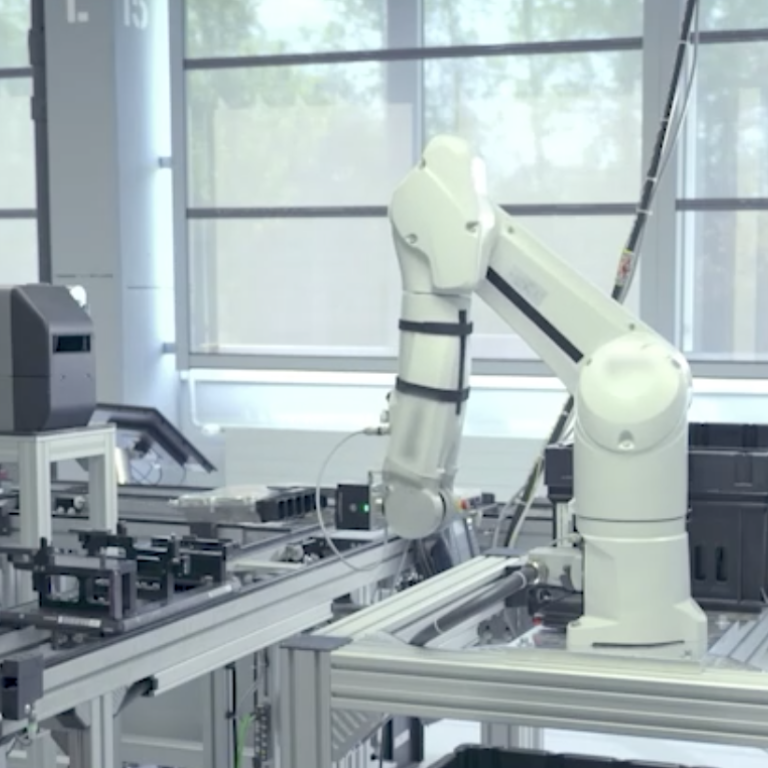5G Transformation Hub
How Ultra Reliable 5G Could Transform Manufacturing
Private 5G networks could provide 99.9999% reliable connectivity inside factories
A Robert Bosch factory is using a private 5G network to provide the ultra-reliable connectivity required to enable greater automation. The trial is testing how enhanced 5G connectivity can be used to control an autonomous robot inspecting parts for any defects.
Select a project
Contents
Challenge
As any downtime costs money, manufacturing plants need their systems to be working all the time. Therefore, automated inspection systems need to be managed using ultra-reliable connectivity that will always deliver the data robots require to make correct decisions. These systems also need to be highly responsive and highly secure to ensure safety within the manufacturing plant.
Solution
Qualcomm and Bosch Rexroth are trialling a new 5G-based automation solution at the Robert Bosch Elektronik factory in Salzgitter, Germany. The solution harnesses time-synchronised networking (TSN) and coordinated multi-point 5G connectivity to control an autonomous mobile robot, and 5G precise positioning to locate an automated guided vehicle (AGV). After the robot takes a photo of a part, the image is transferred via 5G to a local server, where artificial intelligence (AI) is used to spot defects.
Impact & Statistics
The trial suggests private 5G networks could provide 99.9999% reliable wireless connectivity inside factories, enabling the replacement of wired connections. Private 5G networks can support microsecond-level time synchronization for industrial equipment, centimetre-level precision when positioning vehicles and mobile robots, and leverage AI to detect component defects. Together, these capabilities have the potential to increase productivity and reduce operational costs.
Wider Implications
Ultra-reliable 5G systems could play a fundamental role in enabling the manufacturing sector to adopt Industry 4.0 principles - very high levels of automation, customisation, flexibility and analytics. A TSN 5G system has the potential to enable manufacturers to reconfigure factory floors, to make more efficient use of space and time, and optimise operational processes to drive cost savings and quality improvements.
Stakeholders
Qualcomm Technologies, Bosch, Bosch Rexroth, Robert Bosch Elektronik
02
How Ultra Reliable 5G Could Transform Manufacturing
Private 5G networks could provide 99.9999% reliable connectivity inside factories
In an intensely competitive economy, factories can’t afford any downtime. That makes ultra-reliable systems a must in manufacturing.
A trial in a plant making electronic control units in Salzgitter, Germany, points to how 5G can be sufficiently reliable to support crucial quality control processes. Using technologies supplied by Qualcomm Technologies and Bosch Rexroth, the Robert Bosch Elektronik plant is testing a 5G-enabled system for inspecting manufactured automotive parts.
A private 5G network is used to remotely control an autonomous mobile robot and an automated guided vehicle (AGV). When instructed to perform an inspection, the robot picks up the relevant component from a conveyor belt and holds it under an industrial high-resolution camera. The resulting image is transmitted via 5G to a local server.
Running the Rexroth automation platform, the server hosts an image recognition system, which uses artificial intelligence to spot defects. If the software running on the server decides that the part meets the inspection requirements, it uses 5G to instruct the robot to place it in the accepted storage box on the AGV. The parts that do not meet the requirements are placed in a rejected storage box next to the robot.
The solution uses the time-synchronisation (TSN) feature of 5G to coordinate the actions of the robot, which, in the future, could move to any suitable location in the factory. The trial is also testing a new 5G-enabled precise positioning solution with the goal of using 5G as a common technology platform for ultra-reliable connectivity and precise positioning for mission-critical applications.
Once it is widely deployed, this kind of 5G connectivity could enable manufacturers to reconfigure factory floors to make more efficient use of space and time with flexible manufacturing systems, and optimise operational processes with analytics at the edge to drive cost savings and quality improvements.
To ensure it is sufficiently reliable, the solution used in the trial has built-in redundancy. “It uses a mechanism called coordinated multipoint (CoMP) transmission where we are able to receive the signal on multiple antennas,” explains René Bonse, Industry 4.0 coordinator at Robert Bosch Elektronik. “So if one antenna fades, we can still communicate and this is especially important to keep the cycle times and avoid big disturbances.” Qualcomm Technologies says this approach can achieve 99.9999% reliability.
The trial is exploring how well a private 5G network handles three different requirements simultaneously – the transfer of images from the camera, the TSN connection to the robot, and the positioning of the AGV. “We are showcasing the robot communication is not impacted by the high-speed communication going on in parallel,” explains Fatih Ulupinar, principal engineer at Qualcomm Technologies.
The private 5G network, which has its own 5G core, operates in the 3.7-3.8 GHz frequency band – the spectrum reserved for regional and local networks in Germany. The spectrum can be licensed by an organisation for use in a specific area for a period of up to 10 years. For the trial, Bosch is using a test licence in this frequency band.


Fatih Ulupinar
Principal engineer at Qualcomm Technologies
03
Potential to cut labour costs and defects
Robert Bosch has traditionally conducted optical inspections at dedicated fixed stations built into the production line or, in the absence of such stations, using a manual process. It is now exploring whether it can eliminate the need for manual inspections by deploying a mobile automated system that can be moved around the factory floor to wherever it is needed.
Although Bosch says very careful manual inspections safeguard its high quality standards, they are time-intensive. An automated approach should improve speed and efficiency.
The new automated system “doesn't get tired, so we have actually a 100% correct rate” in the trial, René Bonse adds. However, he cautions it may not be quite so accurate when inspecting parts that require it to spot more subtle optical deviations. The trial uses image recognition software developed by HD Vision Systems, which is installed on the server in the factory’s IT room. René Bonse anticipates the same system could be applied to many other optical inspection use cases, such as checking the pins of the ECU, the labelling, or for scratches on the housing.
Autonomous mobile robots could also be used to ensure production lines have all the raw materials and parts they need. To do that, “you will, of course, need mobility,” notes René Bonse. “If you basically have a robotic arm on an AGV, you can run it very stably and thereby automate the feeding processes in the line. This can also be a big benefit in the future.”
The modular solution used in the trial can be adapted to different use cases. The 5G connectivity enables Bosch Rexroth to split the control application between a physical ctrlX CORE controller onboard and a server in the IT room running a purely software-based virtual version of the ctrlx CORE. “There are advantages in having the automation platform basically stretch over these two controllers,” explains Gunther May, head of technology and innovation, Business Unit Automation and Electrification at Bosch Rexroth. “They have access to the same data when you have this reliable 5G connection running over TSN … this opens a lot of freedom as you can actually build some of these applications in server-like structures, IT-like structures and get much more flexibility regarding performance needs. So, upgrading your machine means you just add another server or a bigger one.”


René Bonse
Industry 4.0 coordinator at Robert Bosch
04
5G combines flexibility, reliability and security
Manufacturing plants need the reliability and responsiveness of wired connections and the flexibility and cost-effectiveness of wireless connections. With 5G, they can potentially have the best of both worlds. Published in July 2020, 3GPP Release 16 introduced new capabilities to 5G, such as enhanced ultra-reliable low latency communication (eURLLC) with millisecond latencies, 99.9999% reliability, and TSN support.
With a private 5G network and local-licensed spectrum, there is little danger of interference from other spectrum users. “For a robot especially, it's important to have a stable and really robust connection of the wireless technology and I see that on 5G,” says René Bonse. “Unlike Wi-Fi, which operates in shared unlicensed spectrum, a private 5G network can guarantee a specific level of throughput and latency”, adds Fatih Ulupinar of Qualcomm Technologies. He also stresses the importance of 5G’s TSN capabilities, which “means, you're able to do one microsecond or better time synchronisation, which is only introduced in 5G. It is not available in the earlier versions.”
Another key feature of 5G is its support for “gated scheduling mechanisms that allows you to provide a timeline as to when the packet should arrive at the destination,” adds Fatih Ulupinar. “So you can guarantee certain cycle times.” He also highlights the importance of the inherent security in a 5G network.
Using the coordinated multipoint transmission approach, the private 5G network can achieve “six-nines or even better reliability without incurring any latency costs through retries of the packets,” Fatih Ulupinar notes. The use of an on-site edge compute server also keeps the latency to a minimum. “So all these technologies come together to solve this use case, which wouldn't be possible with the current version of Wi-Fi or previous generation of [cellular networking] technologies,” he adds.
Support for mobility is important to enable robots and vehicles to be controlled and monitored wherever they are needed. “Quality issues, of course, can happen in manufacturing and you cannot plan for it, so you will not have a station or robot ready on every production line, so we want a mobile system for automating unplanned optical inspections, which we can move wherever we need it,” explains René Bonse. “You need flexibility. It is not cost efficient to have a robot for this purpose in every line, because it doesn’t happen a lot. Sharing the robot between lines increases utilisation.”
The trial participants also believe the 5G positioning technology they are testing could be valuable for manufacturers. During the trial, the technology has been able to pinpoint the position of the robot and the AGV to within 40 cm. Fatih Ulupinar says Qualcomm Technologies is learning a lot about how to refine this technology for use in a potentially-cluttered manufacturing environment. “We are already working on improved versions of the positioning algorithms,” he says, estimating that the accuracy could be improved to below 10 cm.
Employing 5G millimetre wave (mmWave) networks could also make a major difference. Using the “positioning technology in mmWave bands gets much better accuracy than with the 100 MHz available in the 3.7 GHz band in a factory environment,” Fatih Ulupinar explains.
René Bonse envisions that the 5G positioning technology will be used to move equipment, robots and vehicles into the vicinity of each other, before cameras and sensors take over to handle the very precise positioning required to connect one piece of equipment to another.
For Robert Bosch, the trial is yielding valuable insights into how automotive electronics manufacturing could become more flexible. “We really want to build up the knowledge and the network to prepare for the future,” says René Bonse. “This was the first private 5G network that we put up at our location. It was the first time for us to work with the distributed PLC environment and it was the first time for us to connect a robot over wireless. So, there were a lot of new learnings and benefits for us.”

05
Next steps – deployments in 2023
The Salzgitter trial, which went live in March 2022 after five months of preparation, is due to run for several months. As well as testing the new technologies, the test system is being used to demonstrate their potential to third parties in a realistic manufacturing environment. After the trial is complete, Qualcomm Technologies will focus on bringing together an ecosystem to support the deployment of private 5G networks in the manufacturing sector.
In particular, Qualcomm Technologies is working with suppliers of 5G networks to incorporate support for TSN, coordinated multipoint transmission, and 5G positioning into their infrastructure. “
“We expect to see a commercial or a pre-commercial system, which is capable of providing TSN communication, widely available at some point next year,” says Fatih Ulupinar. “But the positioning aspect, I expect, will come little later. It’s in the early stages of development, but I am talking to Bosch and other operational tech company colleagues and they are very enthusiastic about positioning.”
In those countries that haven't reserved spectrum for private 5G networks, Qualcomm Technologies envisions deploying this kind of connectivity in conjunction with mobile operators. In such cases, manufacturers may choose to use 5G mmWave connectivity, which can support very fast throughput over short distances and is inherently isolated from external interference. “The solutions will be very market-specific depending on the requirements and what's available in that particular market,” says Fatih Ulupinar.
He anticipates manufacturers will make use of other advanced features of 5G as they become available. For example, future releases of the standard are set to support the use of artificial intelligence to manage the dynamic allocation of back-up connectivity, reducing the need to build redundancy into all elements of the system.
Another potentially interesting feature for manufacturing is RF sensing – the use of cellular network signals to create a dense three-dimensional map of what is happening in a specific location. This feature could be used to create so-called digital twins of a plant or factory or to recreate the facility in the Metaverse. These solutions could be used to monitor the performance of the plant, and detect any anomalies, such as a security breach or early signs of component wear, as well as running “what if” simulations.


Fatih Ulupinar
Principal engineer at Qualcomm Technologies
06
About
About the GSMA
The GSMA is a global organisation unifying the mobile ecosystem to discover, develop and deliver innovation foundational to positive business environments and societal change. Our vision is to unlock the full power of connectivity so that people,
industry, and society thrive. Representing mobile operators and organisations across the mobile ecosystem and adjacent industries, the GSMA delivers for its members across three broad pillars: Connectivity for Good, Industry Services and Solutions, and Outreach. This activity includes advancing policy, tackling today’s biggest societal challenges, underpinning the technology and interoperability that make mobile work, and providing the world’s largest platform to convene the mobile ecosystem at the MWC and M360 series of events.
For more information, please visit the GSMA corporate website at www.gsma.com.
Follow the GSMA on Twitter: @GSMA.
GSMA 5G Transformation Hub
The GSMA 5G Transformation Hub is a source of information on some of the most innovative 5G solutions in the world. This portal contains case studies detailing design, benefits, key players, measured value and the future impact of scaling up these 5G solutions worldwide. The 5G Era is now firmly established and this family of standardised GSM technologies, including mmWave, are being rolled out successfully across the globe. The GSMA 5G Transformation Hub, launched at MWC Barcelona in 2022, provides details of how 5G is best placed to deliver real value for a range of key sectors including manufacturing, energy, transportation, media and live entertainment, smart cities and construction.. Many more case studies will be added, in the coming months, covering even more industries and the GSMA is asking Members to nominate innovative 5G case studies to add to this global digital showcase. The 5G Transformation Hub and this particular Case Study are both sponsored by Qualcomm.
About this case study
This case study is for information only and is provided as is. The GSM Association makes no representations and gives no warranties or undertakings (express or implied) with respect to the study and does not accept any responsibility for , and hereby disclaims any liability for the accuracy or completeness or timeliness of the information contained in this document. Any use of the study is at the users own risk and the user assumes liability for any third party claims associated with such use.